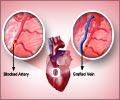Procedure of Coronary Balloon Angioplasty
During the angioplasty procedure, a balloon catheter widens the stenosed area, restoring blood flow to the ischemic section of the heart.
Angioplasty is a suitable procedure in the following conditions:
- Blood flow to a particular part of the heart is decreased due to one or two blocks in the coronary arteries resulting in symptoms like angina and heart attack
- The blocks are accessible to the angioplasty catheter
- The symptoms due to the block cannot be controlled by drugs
- The health of the patient is good enough to withstand the procedure
Coronary Angioplasty - The Procedure
The
The site on the skin near the groin or the arm through which the catheter is introduced is first anesthetized with a local anesthetic. A small incision is made at this site and a catheter referred to as the ‘guiding catheter’ is introduced into a large artery. The catheter is advanced under radiological surveillance along till the coronary artery to the site of the block. A ‘guide wire’ is then introduced through this catheter and is advanced through the blocked part and slightly beyond the block.
A catheter with a deflated balloon, referred to as the ‘balloon catheter’ is then inserted through the first catheter, guided into place by a guide wire. Once the balloon reaches the narrow part, it is inflated, till it widens the artery. Multiple inflations may be needed to widen the artery. The balloon catheter is then withdrawn.
Angiography is repeated to confirm the free flow of blood. The guide catheter may be removed immediately or a few hours following the procedure. The patient is observed for one to two days, and then discharged from the hospital.
In order to prevent restenosis, a
Stents incorporated with certain drugs like paclitaxel, sirolimus, zotalimus and everolimus are also available. These stents, called drug –eluting stents, contain drugs that decrease the chances of restenosis. They, however, sometimes predispose to late restenosis that can occur even up to three years after the procedure. Treatment with anti-platelet drugs may be required for at least one year after the placement of a drug-eluting stent to prevent this complication.
Angioplasty may also be accompanied by atherectomy. Atherectomy is a procedure wherein the clot is broken down before
The angioplasty procedure is said to be successful if a 20% change in inner diameter of the artery is achieved, with the final diameter stenosis <50% and without the occurrence of death, heart attack, or the need for emergency bypass surgery following the procedure.
















